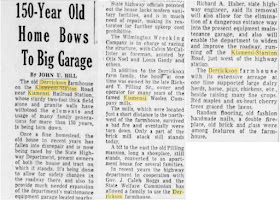
It's been a while since I've posted about any upcoming local events, but there are a few coming up in the next couple weeks that I thought were more than worth mentioning. Two of them are happening this Saturday (September 9), and one is scheduled for a week from Monday (September 18). I'm planning on attending a couple of them myself, but if you're looking for something to do they should all be quite interesting.
Working in reverse order, friend of the blog Ken Shelin informed us a few weeks back that a new historical marker will be unveiled on Monday, September 18 at 1 PM, at the site of the Oliver Evans/Fell Spice Mill on Faulkland Road. I know that this one has personal meaning for Ken, as some of his Woodward ancestors worked at the spice mill in the 1800's. This is a fascinating site that has been covered in various forms here several times, and it's certainly worthy of a marker. I thank Ken for the work he's done on getting the marker, and he notes that Senator Anthony Delcollo was instrumental in securing the funds for it. Thanks guys!
While I won't be able to make it to the marker unveiling that day, there are two events this Saturday that I do plan on attending. The Friends of Brandywine Springs will be conducting their September archaeological dig at the park, from 9 AM to about 3 PM. FOBS has been digging at the park (once a month from the spring to the fall, weather permitting) for about 25 years now, and has made many fascinating discoveries. The current dig site is the former location of a ride whose existence was only recently rediscovered -- the Razzle Dazzle. It was a spinning, circular ride that was only briefly at the park, and whose presence was only noted when Ray Harrington and Tommy Gears resurrected the Lost Motion Pictures of Brandywine Springs. Several footings from the ride have been found already and FOBS hopes to uncover more. If you're interested, the group meets in the parking lot of Brandywine Springs park at 9 AM, then proceeds down to the dig site. I hope to stop by after lunch.
 |
| The Razzle Dazzle at Brandywine Springs Amusement Park |
In the morning, I'll be in Hockessin for another historical event, this one hosted by the Hockessin Historical Society at the Tweed's Tavern and Museum, off of Valley Road near Lantana Square. Beginning at 10 AM, Walt Chiquoine will give a presentation on the Nichols House and the British occupation of the area around September 9, 1777 -- 240 years to the day after the events. This is roughly the same story outlined in the recent blog posts about the Nichols House. If you liked the story, here's a chance to check out the live show! The event is open to the public, but seating is limited. After the presentation, the Tweed's Museum will be open to the public from 11 AM to 1 PM. If you want more information,
here's a story in the Hockessin Community News about Walt, his discoveries, and Saturday's events. I'm very much looking forward to this one. And if by chance you can't make it Saturday but still want to attend the talk, Walt will be giving his full presentation at the Brandywine Battlefield Park on Sunday, September 10, at 2 PM. I've seen this presentation myself, and it's truly fascinating. Hope to see you out there!




















